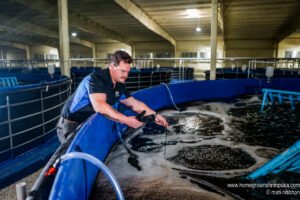Indoor shrimp farming can be a healthy choice both for you and the planet. Here’s why:
Nutritious: Shrimp is a high-protein, low-fat food that is also a good source of vitamins and minerals, including vitamin D, vitamin B12, and selenium. Indoor farming of shrimp can provide a fresh, nutritious product that is free from harmful chemicals and pollutants.
Sustainable: Indoor farming of shrimp is a sustainable alternative to traditional shrimp farming, which can have negative impacts on the environment, such as water pollution and destruction of natural habitats. By controlling the environmental conditions, indoor farming can minimize these impacts and provide a more eco-friendly product.
Reduced Carbon Footprint: Indoor farming of shrimp can reduce the carbon footprint of shrimp production by minimizing transportation and reducing the need for feed inputs. This can help to mitigate the effects of climate change.
Controlled Environment: Indoor farming provides a controlled environment, which allows for the optimal growth and development of the shrimp. This can result in higher yields and better quality shrimp.
Reduced Risk of Disease: By controlling the environment, indoor farming can reduce the risk of disease outbreaks and minimize the need for antibiotics or other treatments, which can be harmful to both the shrimp and the environment.
Overall, indoor shrimp farming can be a healthy and sustainable choice for both you and the planet. It provides a fresh, nutritious product that is produced in an eco-friendly way, minimizing negative impacts on the environment.








